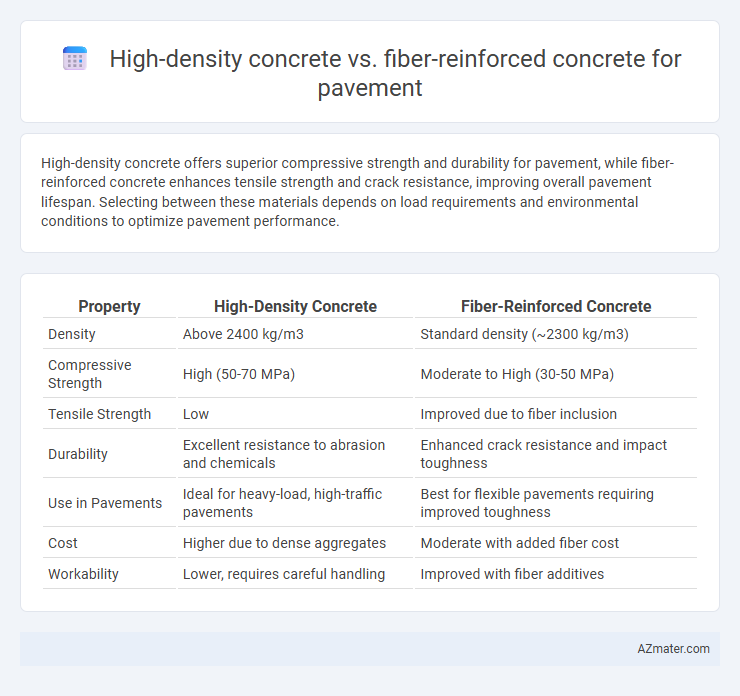High-density concrete offers superior compressive strength and durability for pavement, while fiber-reinforced concrete enhances tensile strength and crack resistance, improving overall pavement lifespan. Selecting between these materials depends on load requirements and environmental conditions to optimize pavement performance.
Table of Comparison
| Property | High-Density Concrete | Fiber-Reinforced Concrete |
|---|---|---|
| Density | Above 2400 kg/m3 | Standard density (~2300 kg/m3) |
| Compressive Strength | High (50-70 MPa) | Moderate to High (30-50 MPa) |
| Tensile Strength | Low | Improved due to fiber inclusion |
| Durability | Excellent resistance to abrasion and chemicals | Enhanced crack resistance and impact toughness |
| Use in Pavements | Ideal for heavy-load, high-traffic pavements | Best for flexible pavements requiring improved toughness |
| Cost | Higher due to dense aggregates | Moderate with added fiber cost |
| Workability | Lower, requires careful handling | Improved with fiber additives |
Introduction to Modern Pavement Materials
High-density concrete offers enhanced durability and load-bearing capacity ideal for heavy-traffic pavements, using heavyweight aggregates like magnetite or barite to increase density and radiation shielding properties. Fiber-reinforced concrete improves tensile strength and crack resistance by incorporating synthetic or steel fibers, which enhance pavement flexibility and longevity under dynamic loads. Modern pavement materials leverage these advanced composites to optimize performance, combining high density for strength and fibers for deformation control in demanding infrastructure applications.
Defining High-density Concrete: Properties and Composition
High-density concrete for pavement is characterized by its increased density achieved through the incorporation of heavyweight aggregates such as barite, magnetite, or iron ore, resulting in a density typically exceeding 3000 kg/m3. This type of concrete exhibits enhanced compressive strength, superior radiation shielding properties, and improved durability under heavy traffic loads. Its composition emphasizes low porosity, high aggregate packing density, and a balanced water-cement ratio to ensure optimal mechanical performance and longevity in pavement applications.
Exploring Fiber-reinforced Concrete: Types and Features
Fiber-reinforced concrete (FRC) for pavement incorporates discrete fibers such as steel, glass, synthetic, or natural fibers, enhancing tensile strength, crack resistance, and durability compared to traditional high-density concrete. The selection of fibers varies based on performance requirements, with steel fibers improving impact resistance, synthetic fibers enhancing freeze-thaw durability, and glass fibers increasing flexural strength. These specialized fiber types and their unique mechanical properties make FRC a preferred choice for pavement applications requiring improved load distribution and extended service life.
Mechanical Strength Comparison: High-density vs Fiber-reinforced Concrete
High-density concrete offers superior compressive strength due to its dense particle packing and high cement content, making it ideal for heavy load-bearing pavement applications. Fiber-reinforced concrete enhances tensile strength and crack resistance by incorporating synthetic or steel fibers, which improve durability under flexural stress and repeated loading. While high-density concrete excels in static compressive load scenarios, fiber-reinforced concrete provides better performance in dynamic and impact conditions through improved toughness and ductility.
Durability and Wear Resistance in Pavement Applications
High-density concrete offers superior durability and wear resistance in pavement applications due to its dense aggregate composition, which enhances compressive strength and reduces permeability, minimizing damage from freeze-thaw cycles and heavy traffic loads. Fiber-reinforced concrete improves toughness and crack resistance by distributing stress more evenly, thereby extending pavement life under dynamic loading but may have slightly lower compressive strength compared to high-density mixes. Selecting between these concretes depends on balancing ultimate durability needs and flexural performance to optimize pavement longevity.
Handling and Workability in Construction Processes
High-density concrete offers superior load-bearing capacity but presents challenges in handling due to its increased weight and reduced slump, requiring heavy machinery and careful placement techniques in pavement construction. Fiber-reinforced concrete enhances workability by improving tensile strength and crack resistance without significantly increasing density, facilitating easier mixing, transporting, and finishing processes. Efficient workability in fiber-reinforced concrete reduces labor costs and speeds up construction timelines compared to the traditional handling demands of high-density concrete.
Sustainability and Environmental Impact Assessment
High-density concrete, known for its enhanced durability and radiation shielding properties, typically relies on heavy aggregates like magnetite or barite, which can increase environmental burden due to mining and transportation impacts. Fiber-reinforced concrete (FRC) incorporates synthetic or natural fibers that improve tensile strength and crack resistance while potentially reducing the need for steel reinforcement, contributing to lower embodied energy and enhanced sustainability. Life cycle assessments often favor FRC for pavement applications as it extends service life, decreases maintenance frequency, and minimizes resource consumption, supporting reduced carbon footprint and environmental impact in infrastructure projects.
Cost Analysis: Material and Long-term Maintenance
High-density concrete generally incurs higher initial material costs due to its dense aggregates and specialized components, while fiber-reinforced concrete typically costs less upfront but requires specific fiber additives, influencing price variability. Long-term maintenance expenses for high-density concrete tend to be lower because of its enhanced durability and resistance to heavy loads, reducing repair frequency. Fiber-reinforced concrete offers improved crack control and flexibility, which can minimize surface damage but may necessitate more frequent inspections and maintenance over the pavement's lifespan.
Case Studies: Real-world Performance in Pavement Projects
Case studies comparing high-density concrete and fiber-reinforced concrete in pavement projects reveal distinct performance advantages rooted in material properties. High-density concrete showcases superior load-bearing capacity and durability under heavy traffic conditions, as demonstrated in highway applications in Japan where reduced deformation extended pavement life by over 30%. Fiber-reinforced concrete improves crack resistance and impact toughness, evident from urban road projects in the United States that reported a 25% decrease in maintenance costs due to enhanced durability against thermal expansion and contraction.
Conclusion: Choosing the Optimal Concrete for Pavement
High-density concrete offers superior durability and load-bearing capacity for pavements exposed to heavy traffic and harsh environmental conditions, making it ideal for critical infrastructure projects. Fiber-reinforced concrete enhances tensile strength and crack resistance, extending pavement lifespan under dynamic loads and temperature fluctuations. Selecting the optimal concrete depends on balancing structural demands, expected service life, and maintenance considerations specific to pavement applications.

Infographic: High-density concrete vs Fiber-reinforced concrete for Pavement
 azmater.com
azmater.com